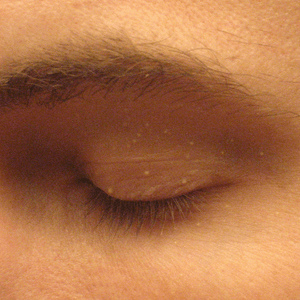Milium (dermatology)
"Milia" redirects here. For other uses, see Milia (disambiguation).
| Milia | |
|---|---|
 | |
| Milia on the eyelid of an adult male | |
| Classification and external resources | |
| Specialty | dermatology |
| ICD-10 | L72.8 (ILDS L72.830) |
| ICD-9-CM | 374.84, 704.8, 706.1 |
| DiseasesDB | 001367 |
| MedlinePlus | 001367 |
| eMedicine | article/1058063 |
| Patient UK | Milium (dermatology) |
.jpg)
Milk spots (milia) on the nose of a 1-week old infant
A milium (plural milia), also called a milk spot or an oil seed, is a clog of the eccrine duct, the true sweat gland. It is a keratin-filled cyst that can appear just under the epidermis or on the roof of the mouth.[1][2]:780 Milia are commonly associated with newborn babies but can appear on people of all ages.[3]:680 They are usually found around the nose and eyes, and sometimes on the genitalia, often mistaken by those affected as warts or other sexually transmitted diseases. Milia can also be confused with stubborn whiteheads.
In children, milia often disappear within two to four weeks. For adults, they can be removed by a physician (a dermatologist will have specialist knowledge in this area).
See also
References
| Wikimedia Commons has media related to Milium (disease). |
- ↑ "milium" at Dorland's Medical Dictionary
- ↑ Freedberg, et al. (2003). Fitzpatrick's Dermatology in General Medicine. (6th ed.). McGraw-Hill. ISBN 0-07-138076-0.
- ↑ James, William D.; Berger, Timothy G.; et al. (2006). Andrews' Diseases of the Skin: Clinical Dermatology. Saunders Elsevier. ISBN 0-7216-2921-0.
This article is issued from Wikipedia - version of the 9/9/2016. The text is available under the Creative Commons Attribution/Share Alike but additional terms may apply for the media files.